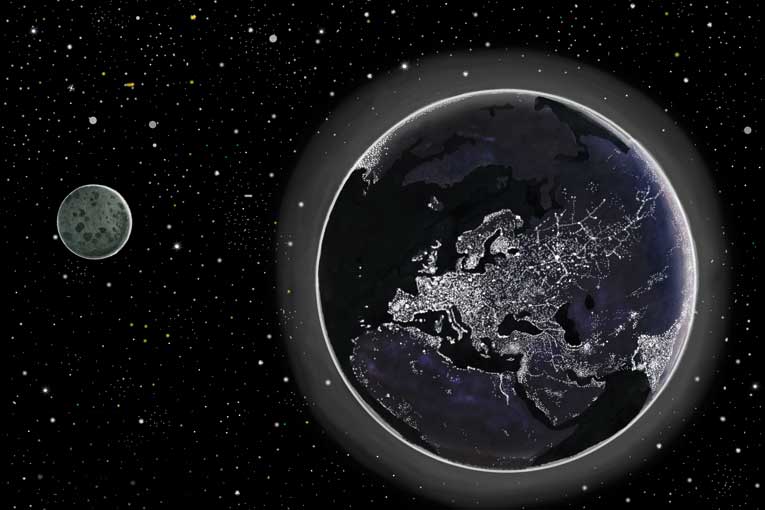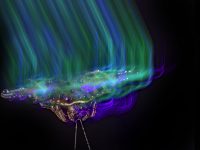
Microbes and stars could seem absolutely different things, but they share two distinctive characteristics. The first is quite obvious: to observe them, both huge stars and tiny microbes, we need instruments based on electromagnetic waves. Microbes can only be seen through microscopes, either those that use radiation from visible light (optical microscopes with a wavelength between 400 and 700 nm), or those using the electron radiation, with much smaller wavelengths. And although with the naked eye we can see a few hundred stars, to observe most of them we need visible-light telescopes and other types of instruments that detect a broad spectrum of radiation, from shorter, like X-rays, to the longest, such as radio waves.
The second characteristic is that both microbes and stars have a huge number of individuals. Only in the Milky Way there may be over 100,000 million stars. And, surely, the known universe has more than 100,000 million galaxies. But, even though this number is incredibly high (1022, and surely we fall short in the calculation), the number of microbes on Earth is many orders of magnitude higher: it is estimated that it reaches more than 1030.
But this fact would have gone unnoticed, as another one of the facts that characterise our universe, were it not for a rather small planet orbiting a medium star – both in size and age – within one of the many galaxies in the cosmic region, where an intelligent organism emerged with the intelligence and ability to observe, study and marvel at it. The galaxy, as we said, is the Milky Way. The medium-sized star is the Sun. The small planet is the Earth. The intelligent organism, the human species.
The United Nations declared 2015 as the International Year of Light and Light-based Technologies (IYL 2015). It is a proposal that attempts to highlight the great achievements that have been made on the knowledge and application of light and the importance of this scientific knowledge for the welfare of humanity. This event has the support of UNESCO, scientific societies and academic institutions of many countries, as well as technological platforms and private organisations that wish to promote and highlight the significance of light and its applications. The celebration of IYL 2015 by many scientific societies and the various activities undertaken during the year are related to the physical aspects of light, which is celebrated and studied from the physical point of view. Many different countries, including Spain and Portugal, have appointed committees in charge of the commemoration, committees that are integrated primarily by physicists and technologists.
«Without humans, nobody would notice the wonders of nature. Humans are
the eyes of Gaia»
But light can be considered from many points of view. Light is essential for the development of life on Earth, has determined animal and plant evolution, and has also a role in many aspects of culture and art (painting, photography, cinema, etc.). It is, therefore, necessary to consider that 2015 is also the celebration of what might be called the «International Year of Light and its Effects on Life». The year 2015 also marks several anniversaries, including the publication, in 1015, of the first book on optics, written by Muslim astronomer and mathematician Ibn al-Haytham (latinised as Alhazen, Basra, 965 – Cairo, 1040). This book has had a great influence on subsequent western thinkers such as Roger Bacon or Johannes Kepler.
Light was fundamental for the evolution from the first stages of life on Earth. Light brought energy to the first ecosystems through the process of photosynthesis. Light allowed organisms to fix CO2 and reduce it with hydrogen to convert it into food, usually carbohydrates. Initially, hydrogen came from chemical reactions, mainly from hydrogen sulphide (H2 S), very abundant in the early Earth, due to the numerous volcanoes at that time. The first photosynthesis produced food like at present, but it did not give off oxygen, but sulphur, which was deposited into small granules.
Life on Earth began ca. 3850 Ma ago. No later than three hundred million years afterwards, there was a phenomenon that caused a biological disaster and that became the cause of the first great extinction in the planet. Bacteria now known as cyanobacteria (or «blue algae») invented a new system of photosynthesis. A system that instead of taking hydrogen from the sulphide molecule – or from other small molecules present in the medium – , broke water (H2 O, even more abundant that hydrogen sulphide), splitting it into hydrogen and oxygen. Hydrogen (protons) entered cells and combined with CO2. With this, these cyanobacteria reached a desirable effect, a large facility to produce food (i.e. carbohydrates, compounds of CO2 and hydrogen), since the supply protons was fully guaranteed. But they also get an undesirable effect (at first), the disappearance of most of the organisms living on Earth at that time. And, why is that? As a result of breaking the water molecule, a horribly toxic and poisonous gas for anaerobic life (life without oxygen), the only kind of life on the planet at the time, was released.
This poisonous gas was oxygen. Most organisms became extinct at that early stage of life. Organisms were burned by oxygen, and only some who developed the enzymes to protect themselves, survived. And, slowly, this highly reactive gas was escaping into the atmosphere where, together with nitrogen gas, it also produced by bacteria, formed the air and allowed the development of aerobic life and the great evolution erupted from this time.
The Earth is a special planet in the solar system. It is the only planet with its own light, and from different origins. All planets and other bodies from the solar system have no light; they can only reflect light received from the Sun. But the Earth «produces» light: light coming from fires and volcanoes, but also from human lighting, and from several animals, plants and fungi that have luminescence. The Earth is also special because it contains life. And over more than 3,850 million years on Earth, evolution came to create intelligent beings who can interpret and explain the causes of evolution and the mechanisms and laws governing the universe in which we exist. Our species, at least to our knowledge, in the solar system, is the only one that asks itself for its past and tries to regulate its future. Without humans, Earth and the solar system will exist, yes, but nobody would interpret them, nobody would notice the wonders of nature. Nobody would see the forces and the logic of the universe. Not surprisingly, according to James Lovelock’s fortunate phrase, «humans are the eyes of Gaia».





